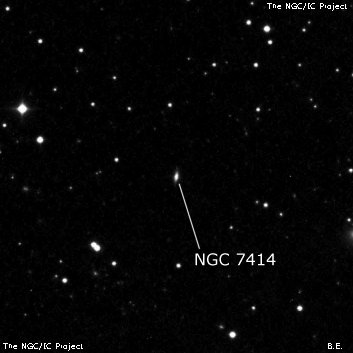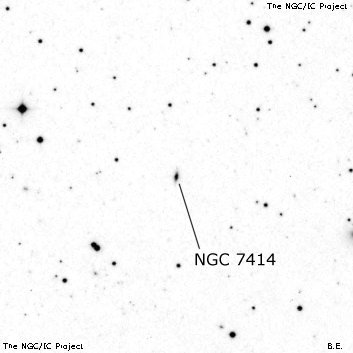NGC/IC Project Restoration Effort
(This is a very very beta version)
NGC7414


Basic Information
Location and Magnitude
Right Ascension: 22:55:24.3
Declination: +13:14:56
Constellation: PEG
Visual Magnitude: 16.0
Historic Information
Discoverer: Swift L.
Year of discovery: 1886
Discovery aperture: 16.0
Observational
Summary description: eeF, S, R, v diffic, n of 2
Sub-type: S0
Corwin's Notes
=====
NGC 7414. Steve Gottlieb wrote in August 2010 that he had finally seen this
galaxy. He was at a site in the Sierra Nevada Mountains in Northern
California, 8200 feet above sea level, observing on a splendid, still, dark
night. Yet, even with his 18-inch reflector, he had trouble spotting NGC
7414. With averted vision, knowing exactly where to look, he had it in view
only 25% of the time he swept over its place.
With that kind of an observation, he suggested that this may not have been the
object that Swift saw. Yet, since it is the only companion to NGC 7413, my
feeling is that it must be the galaxy found by Swift. I think that Swift may
have found NGC 7413 (which see for more) while sweeping, then noticed NGC 7414
in the field.
It is nevertheless one of the faintest of Swift's discoveries. Other galaxies
with the same "eeeF, eee diff" description in his 4th list are considerably
brighter:
NGC V
6034 13.9
6275 15.1
7066 (14.0) from RC3 m_B = 14.8 and approximate B-V = 0.8
7414 15.7
and
7413 14.2 for reference
These magnitudes come from SDSS, their g-band "Cmodel" magnitudes converted
with a transformation equation from their Web site
V = g - 0.59(g-r) - 0.01
(this equation is really only appropriate for stars -- galaxies have complex
spectra that complicate magnitude and color transformations -- but is still
useful for comparing one galaxy in the same system to another).
So, while I think that Swift probably did see the object, Steve's comment is
well-justified!
Steve's Notes
=====
NGC 7414
18" (8/12/10): extremely faint, very small, irregularly round ~15"x12", required averted vision and visible at most 25% of the time but could repeatedly glimpse in the same position once the location was pinpointed. Based on the difficulty of this object in superb conditions, I feel this galaxy was probably too faint to have been discovered by Swift with his 16" refractor.
18" (11/22/08): Not seen at 175x or 283x.
18" (10/25/08): Not seen at 175x or 283x.
17.5" (9/2/89): Not seen at 220x.



